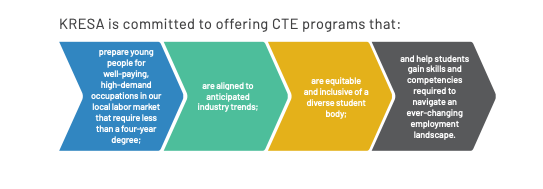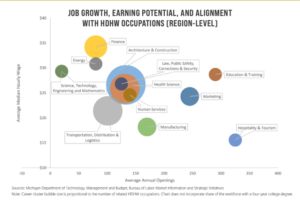 Setting up students for success after high school and beyond
Setting up students for success after high school and beyond
By Haley Jones, MASA Marketing & Digital Media Specialist
In an effort to support a multiplicity of learning opportunities and pathways for students, the team at Kalamazoo Regional Educational Service Agency (KRESA) is reimagining Career Technical Education (CTE) in Kalamazoo County.
 Through research and study groups, the team found that statewide enrollment in CTE has grown significantly since 2014, and that roughly seven of every 10 jobs available require a professional or skilled trades certificate or two-year degree. KRESA is taking that data and running with it, with a goal to set up students throughout the county for success after high school and throughout their career.
Through research and study groups, the team found that statewide enrollment in CTE has grown significantly since 2014, and that roughly seven of every 10 jobs available require a professional or skilled trades certificate or two-year degree. KRESA is taking that data and running with it, with a goal to set up students throughout the county for success after high school and throughout their career.
“Our work really is not to set a student up for one job, but to say, ‘how can we get you to a place where you are in an industry or career field with well-paying, in-demand occupations and we are working together to create a plan for your long-term success,’” said Sarah Mansberger, executive director of Workforce and Community Initiatives at KRESA.
KRESA staff are looking through a local lens – jobs available right there in Kalamazoo County – while also analyzing job market and wage data outside of the county to see how it compares as they work to update curriculum and programming, as well as design a new CTE facility for the RESA.
To start their reimagination process, the team started with the definitions and the numbers. What does it mean for a job to be well-paying and in-demand?
KRESA partnered with the Upjohn Institute for Employment Research to look at the median income for the county. Mansberger said they used a wage calculator from the Massachusetts Institute of Technology (MIT), and local economic data, and found that, in Kalamazoo County a wage of $20 per hour, or about $41,600 annually, is above the median and represents a living wage for a single wage earner with no dependents.
As for what an “in-demand job” means, the team worked with the Upjohn Institute to establish a threshold for what is considered high-growth in Kalamazoo County. An occupation is considered “in-demand” if it is projected to increase by more than 3% over a projection period, Mansberger said. This 3% growth rate is below what is projected for the 2016-2019 period for the U.S., for Michigan and for Kalamazoo/Portage, according to a report issued by KRESA with all of the district’s findings, but continues to represent occupations with growth in the region.
McKinsey Global Institute’s July 2019 report, “The Future of Work in America,” anticipates an increasingly symbiotic relationship between worker and machine: machines will do much of the hard labor, while employees will spend their time and talent interfacing with machines or robots that enable productivity. That means employers are looking for workers who have cultivated 21st Century skills alongside technical skills.
The Center on Education and Workforce at Georgetown University identified “the five most in-demand competencies across the labor market” as:
- Communication
- Teamwork
- Sales and customer service
- Leadership
- Problem solving and complex thinking
 In Kalamazoo County, educators are using these reports, along with data from an employer survey, to create robust programs that will help students find, keep, and grow in industries as a whole – not just one specific job. It has become an all hands-on-deck situation, working with students, parents, leaders in the community, and business leaders right there in Kalamazoo County.
In Kalamazoo County, educators are using these reports, along with data from an employer survey, to create robust programs that will help students find, keep, and grow in industries as a whole – not just one specific job. It has become an all hands-on-deck situation, working with students, parents, leaders in the community, and business leaders right there in Kalamazoo County.
In June 2020, KRESA launched a CTE Steering Committee comprised of roughly 50 local education, business and community leaders to recommend CTE course areas to the Kalamazoo RESA Board of Education.
These course recommendations also informed facilities design for a new CTE Center planned for the district in Fall 2024. Their goal is to create a “world class CTE center” that will serve students from across the county.
“For all of the turmoil that is happening in the world, this is definitely a bright spot,” Mansberger said.
For other districts interested in transforming CTE in their region, Mansberger suggested starting with the numbers and where your county fits into the bigger picture. What does well-paying and in-demand mean in your county? What do the forecasts show for job projections there? What are regional employers looking for when hiring?

It’s a collaborative process, she said, and one that will provide meaningful, equitable opportunities for young people to see what they can be and develop their skills, all while supporting a thriving, more equitable region.
Part of this journey is making sure that every adult who interacts with a student knows how valuable this CTE transformation is. As teachers and counselors look at a student’s educational trajectory, CTE can be brought into the discussion to help young people thinking about who they are, what opportunities align to their interests, and how they can see those interests reflected in a future job, she said.
“If you can’t see it, you can’t be it, so how do we support young people and help them see what is out there, where their interests lie, and what is right there in our own backyard?” Mansberger said.
